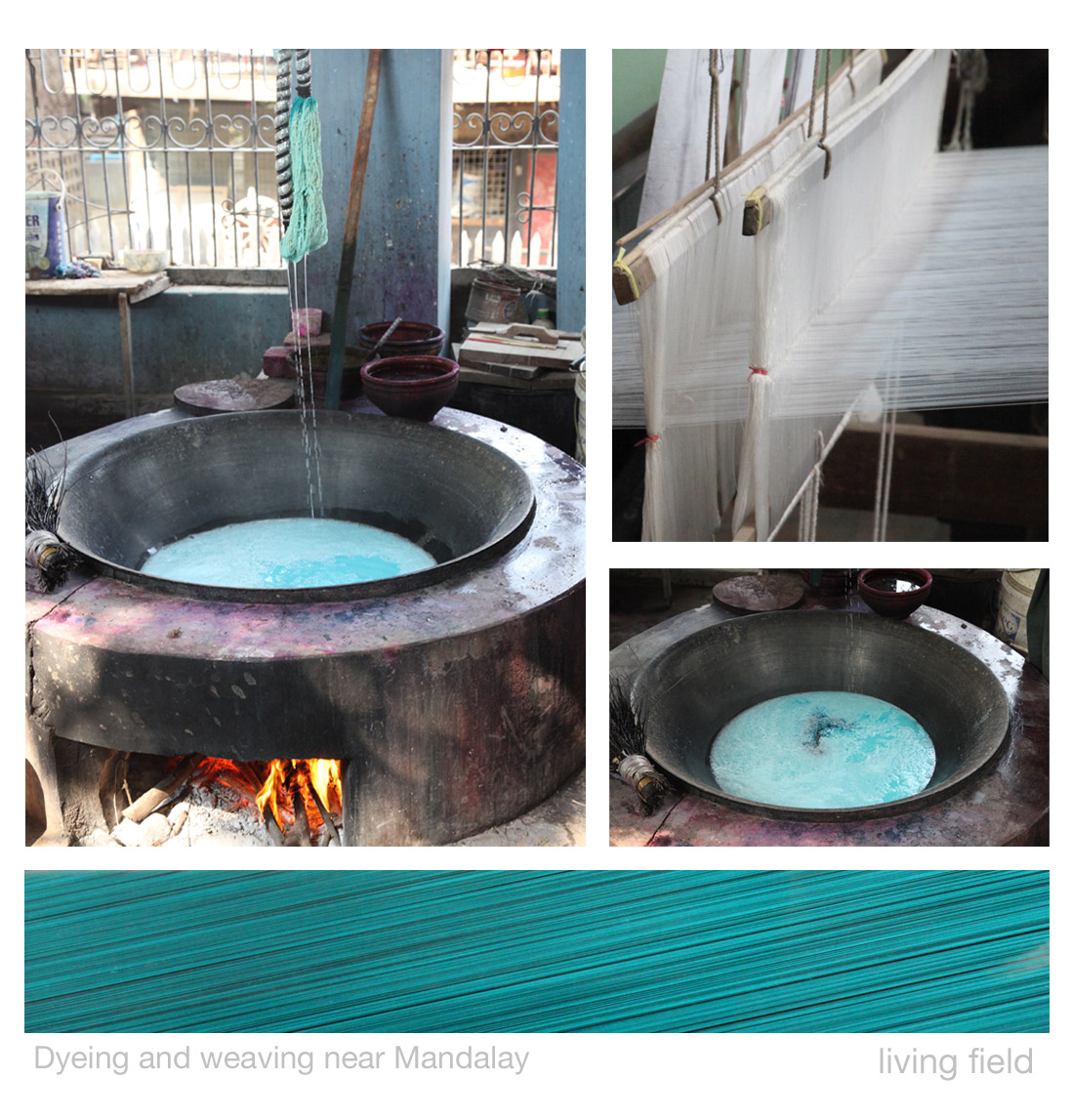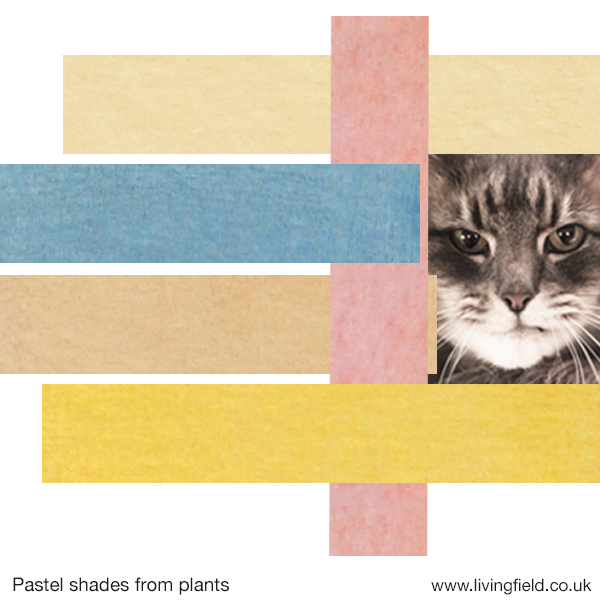Web sites, books, where to get dyes, things to do with natural dyes.
Introduction
There are many dye plants that grow wild or in the garden in temperate latitudes. Some of the parts that hold the dye pigments are seasonal – for example, various berries and flowers. Others – like rhubarb and dock roots – can be sampled at any time.
Some of the traditional dye plants are now rare or live in sensitive habitats. So sampling from the wild should be done with consideration and should not be done at all in near-natural habitats.
The best way is to grow the plants in a garden. Weeds such as nettle and dock do not need much help, and rhubarb lasts for years unaided, but many of the species listed on this site grow easily from seed. The Living Field garden kept a collection of around 20 dye plants.
The plants can be cut and boiled according to the various instructions in the web (e.g. see wildcolours). In most cases, no specialist equipment is needed other than boiling water and a pan. And the smells rarely last – there is no need these days to have buckets of urine standing aound.
To fix dyes, for example in yarn and cloth, you will need to work with additives and mordants, which can be bought along with a range of tropical dyestuffs from suppliers.
Working with dyes is fun – using natural material to create something useful – the same as making bere bannocks or oatcakes from local grain or meal, and then eating them. Once you get hooked …
Images above are of a small dyeing and weaving works near Mandalay, Burma (Myanmar), taken February 2015 (Squire). The dyes are heated in the metal bowl and the fabric immersed for the required period. The name of the blue dye was not discovered but natural and manufactured dyes were sometimes used together. Weaving was by hand-loom, undyed white fibre shown top right and blue-dyed fibre, bottom.
Advice and supply
An excellent online source of information and products can be found at Wildcolours: www.wildcolours.co.uk. Also see their www.woad.org.uk and www.cochinealdye.com.
Thanks to wildcolours for their advice and attention to detail in providing the Living Field with dyed wools, dyestuffs and various materials and extracts.
Contacts have also introduced us to AppleoakFibreWorks based in Ireland, and selling a wide range of dyestuffs and fabrics: see Instagram @appleoakfibreworks and for sales of materials check their web site.
Museums and other places to visit
Natural dyes do not tend to be the subject of whole museums and heritage centres as are the natural fibres. However, something on colouring fabrics can be found in many of the ‘places to visit’ in the 5000 Years Fibres pages.
Several photographs on the Dyes pages were taken at two places where hand-dyeing is still practiced commercially:
- Souk des teintures, Marrakech Morocco
- Mandalay, Burma (Myanmar), also for hand weaving
At both locations, dyestuffs were sometime mixed in the vat or pan; and from what could be understood, the dyers sometimes mixed dyes to get their desired colour.
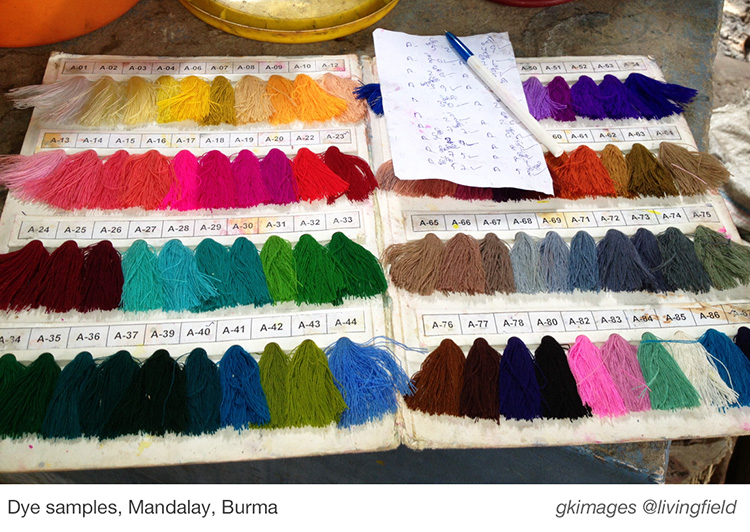
Books, references and web links
The following reference list is not intended to be complete or authoritative, but indicates some of the papers and books used to inform the dyes pages.
Web resources
See www.wildcolours.co.uk for more comprehensive references lists of dye plants and dying relevant to Britain and places overseas.
The Dye Woorkes: comprehensive and detailed resource for dyes and fabrics, providing copy from many old manuscripts, www.elizabethancostume.net/dyes
Ciba Review 1. Medieval Dyeing (1937, Basle). Excellent online copy from elizabethancostume.net giving detail on the plants and methods.
Anne Liese’s Fibers and Stuff has pages on dying and the history of dyes. [Still available online Feb 2022 – try a search].
The Woolgathers – Looms, Linens, Lessons. Sources and references to dyeing and natural fibres (US based) www.woolgatherers.com
The colorantshistory.org web site deals mainly with chemical manufactures (synthetic dyes) but has articles on natural dyes.
Lynne Ross’s workshop, Arran – the Gallery page gives examples of the colour of natural dyes: www.lynngrayross.co.uk/page/Gallery
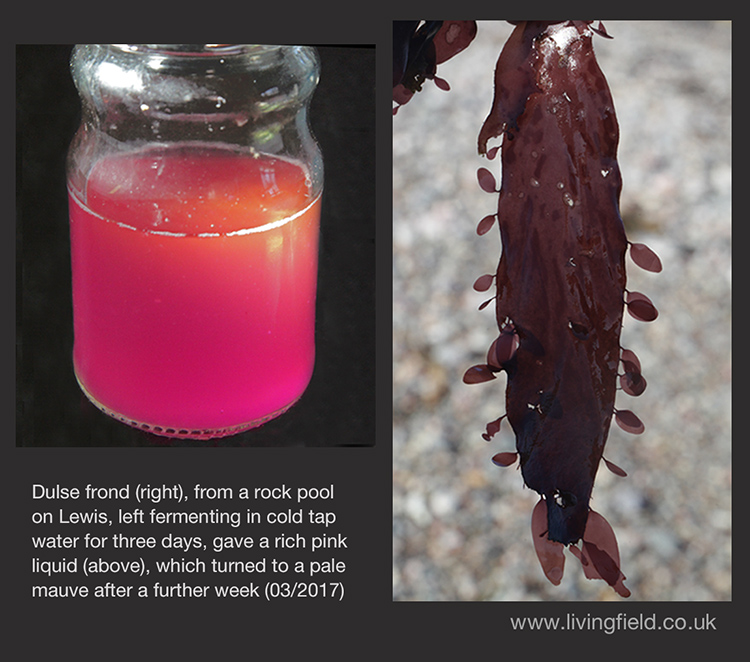
Britain
Crowfoot E, Pritchard F, Staniland K. 1992. Textiles and clothing 1150-1450. Museum of London (new edition 2001).
Darwin T. 1996, 2008.The Scots herbal. Publisher: Mercat/Berlinn. [Section on plant dyes pages 37-42 in the 2008 edition.]
Grierson S. 1986. The colour cauldron – history and use of natural dyes in Scotland. Publisher: Mill Books, Perth.
Grigson G. 1958. The Englishman’s flora. Paperback published 1975 by Paladin, St Albans, UK.
Lawson, P and Son. 1852. Synopsis of the vegetable products of Scotland. Edinburgh: Private Press of Peter Lawson and Son. [One of the best reference manuals to thr crops and varieties grown in Scotland in the early 1800s.]
Milliken W, Bridgewater S. 2004. Flora Celtica: plants and people in Scotland. Publisher: Berlinn. [Notes on dye plants occur throughout the chapters – search the index by species, e.g. dulce, iris…]
Thirsk J. 1997. Alternative agriculture. A history from the Black Death to the present day. Oxford University Press. 365 pages. [For commercial growing of dye plants in Britain.]
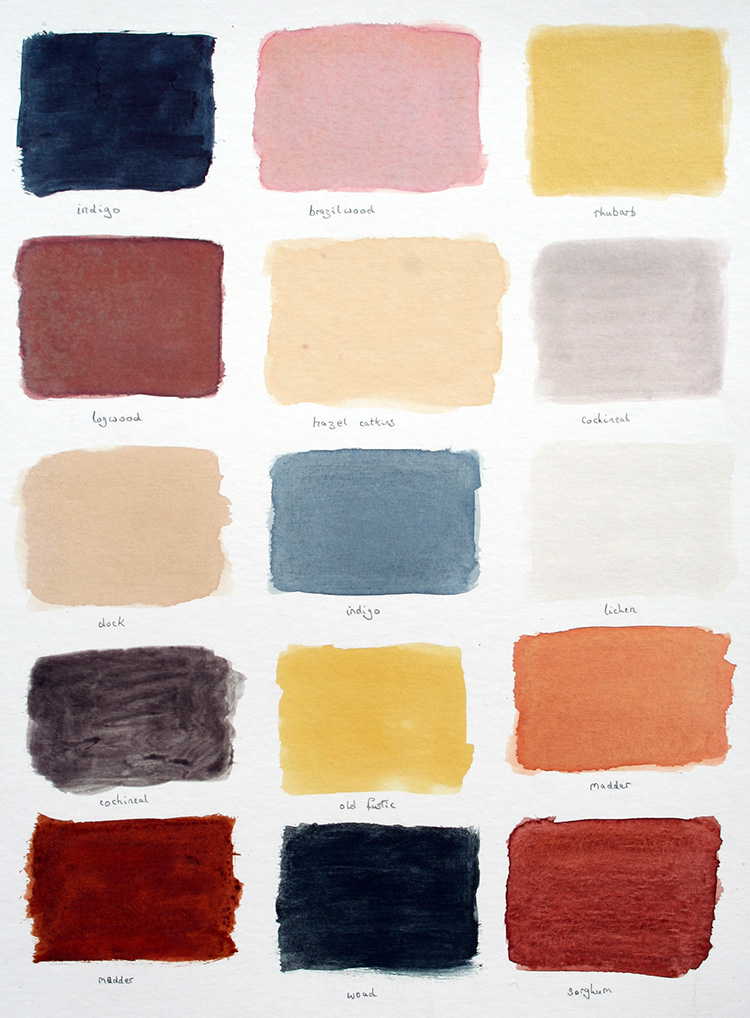
Madder – Turkey red
Turkey red dye from madder raised much interest in north-west Europe in the 1700s and 1800s because of the striking depth and durability of the pigment and then the complex process needed to dye and fix colour from the raw material.
National Museums of Scotland: Colouring the Nation. Includes examples and references to the manufacture and use of Turkey-red in Scotland and more widely.
Rae, Jane. Seeing Red, the Turkey-red dying industry in Glasgow. On the Patchwork and Quilting web site.
Arthur, Liz. Printing and turkey red dying. [Online links may have disappeared.]
Cliffe, WH. Turkey red in Blackley. A chapter in the history of dyeing. Extract from Cliffe’s papers, not dated. Previous link given on this page no longer works; possibly still available online – try a search. The history and subsequent development of a dye works in Blackley, Manchester is given on Wikipedia at Hexagon Tower.
Travis, Anthony S, 1994. Madder red – a revolutionary colour. Chemistry and Industry, January 3 1994, p. 28. Possibly still available online – try a search.
Tropics, sub-tropics and other places further afield
Anderson EF. 1993. Plants and people of the Golden Triangle: ethnobotany of the hill tribes of northern Thailand. Dioscorides Press (Timber Press) / Silkworm Books, Chiang Mai, Thailand.
Barber EW. 1999. The mummies of Urumchi. Norton and Company, New York.
Bradshaw Foundation: an online resource for global rock art www.bradshawfoundation.com
Burkhill IH. 1935. A dictionary of the economic products of the Malay Peninsular. Reprinted 1966, published on behalf of the Governments of Malaysia and Singapore by the Ministry of Agriculture and Cooperatives, Kuala Lumpur, Malaysia. Two volumes, 2444 pages. [Two tomes weighing several pounds that are repeatedly found to be authoritative on useful tropical plants.]
Mallory JP, Mair VH. 2000. The Tarim Mummies. Paperback edition 2008. Thames and Hudson, London.
Morphy H, 1998. Aboriginal art. Phaidon Press; latest reprint 2013. [Use of natural pigments from prehistoric rock art to the present time.]
General
Stearn WT. 1966. Botanical Latin. Fourth edition published 1992 by Timber Press, Portland Oregon, USA. [For the details on animal dyes in particular.]
Back to …
Contact for this page: geoff.squire@hutton.ac.uk

